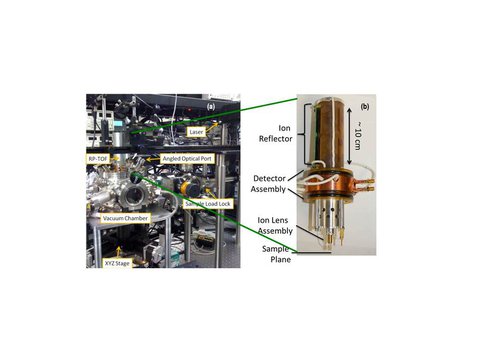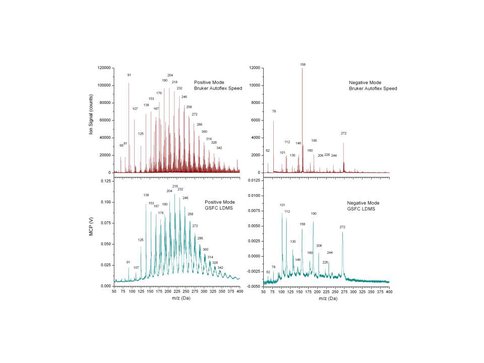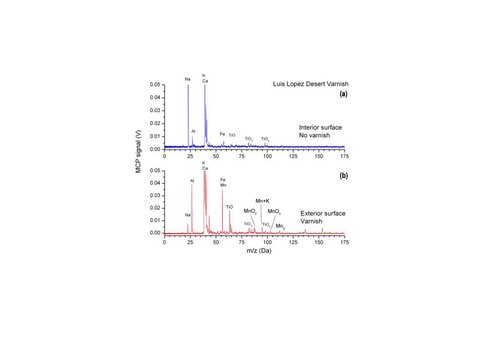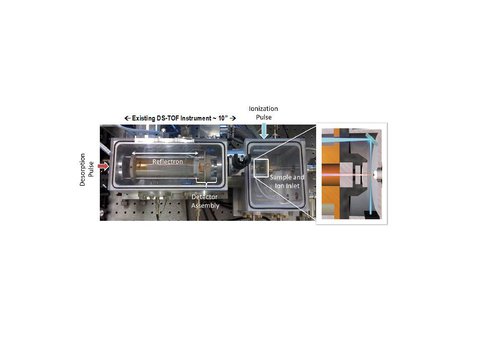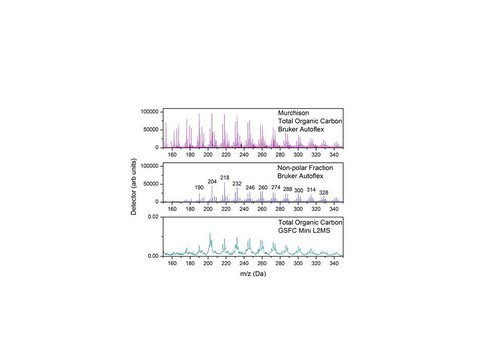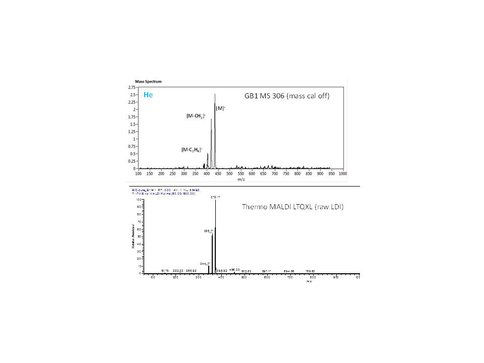2011 Annual Science Report
 NASA Goddard Space Flight Center
Reporting | SEP 2010 – AUG 2011
NASA Goddard Space Flight Center
Reporting | SEP 2010 – AUG 2011
Advancing Techniques for in Situ Analysis of Complex Organics
Project Summary
Our research in laser mass spectrometry is part of the overall program of the Goddard Center for Astrobiology to investigate the origin and evolution of organics in planetary systems. Laser mass spectrometry is a technique that is used to determine the chemical composition of sample materials such as rocks, dust, ice, meteorites in the lab. It also may be miniaturized so it could fit on a robotic spacecraft to an asteroid, a comet, or even Mars. On such a mission it could be used to discover any organic compounds preserved there, which in turn would give us insight into how Earth got its starting inventory of organic compounds that were necessary for life. The technique uses a high-intensity laser to “zap” atoms and molecules directly off the surface of the sample. The mass spectrometer instantly captures these particles and provides data that allow us to determine their molecular weights, and therefore their chemical composition. Our recent work has been to understand the different kinds of spectra one obtains when analyzing complex samples that are analogs of Mars and other planetary bodies, such as desert-varnished basalts and extracts of the Murchison meteorite. We also have been improving the instrument to better detect certain kinds of organic compounds in such complex rocks, such as to selectively ionize certain hydrocarbons and simplify data analysis, and to maintain high vacuum integrity while changing out samples. Finally, our work on improving operational protocols for laser analysis of samples had helped the design of the mass spectrometer on the 2018 ExoMars rover mission, which includes a pulsed laser mode.
Project Progress
Note: This report covers the period July 2010 – June 2011, Goddard Center for Astrobiology (GCA) Theme 4 work using laser time-of-flight mass spectrometry (TOF-MS) techniques included activities under CAN-5 (started FY09).
1. Objectives
The overall objective of the line of work associated with technique and protocol development using laser mass spectrometry (MS) is to develop protocols for analysis of complex, nonvolatile organic molecules, such as those that might be found at Mars, Titan, comets, and other planetary bodies, with limited chemical sample manipulation, preparation, processing (as may be required by flight missions). The GCA laser MS effort is complementary to both (i) instrument development work supported by NASA programs such as ASTID, to forward the design and testing of new prototype spaceflight hardware, and (ii) ongoing research and development within Theme 4 of the GCA, concerning analytical chemical sample analysis as well as across GCA (particularly with Theme 3) to define combined analysis techniques that may affect future mission design. There are additionally aspects of this effort that relate to understanding synthetic pathways for certain complex organics in planetary environments. Areas of activity with GCA support during this period included:
- Improvement of instrument for higher-quality GCA lab work
- Studies of natural analogs with direct desorption MS
- Two-step laser MS (L2MS) development and analysis of meteorite samples
- Astrobiology analog sample collaboration with Mars Organic Molecule Analyzer Mass Spectrometer (MOMA-MS) flight instrument
2. Summary of Progress
2.1. Instrument upgrade for improved GCA lab work
The development of the reversible polarity time-of-flight mass spectrometer (RP-TOF-MS) under an ongoing ASTID effort has enabled us to provide a systematic comparative analysis of planetary samples with both laboratory-grade and flight prototype capabilities. While potential protocols for future flight instruments may be effectively developed in the lab using commercial hardware and a variety of sample preparation approaches, a concurrent prototype development provides key guidance under realistic performance conditions. In the case of the RP-TOF-MS instrument, a set of hardware and operational enhancements has been developed with GCA support, to improve our ability to make such comparisons. These include support of an off-axis (short focal length) laser focusing configuration, installation of an external XYZ stage and a load lock, and developing a common sample mount for several instruments. In other words, the RP-TOF-MS has been augmented to permit exploration of a fully trade space to optimize its ability to detect low levels and complex mixtures of organic and inorganic species from diverse planetary samples.
Figure 1 shows the laboratory setup of the RP-TOF-MS (a) and the mass analyzer (b), which is mounted in the short vacuum section extending vertically from the sample chamber. To accommodate oblique laser incidence, improved microimaging, and a potential improvement in ion focusing from point-by-point analyses of rough surfaces, we developed a new ion extraction lens assembly for the RP-TOF. This assembly revises the existing asymmetric Einzel lens profile to reduce the outer diameter to approximately 4 mm. The profile of the ion inlet is small enough to accommodate all possible laser and imaging angles from positions adjacent to the TOF flight tube. It is also sufficient to achieve optimal light collection for reflectance spectroscopy of the sample such as under development in a parallel ASTID effort (Chanover et al.) using coaxial mirror surfaces.
Figure 1a also shows the recently installed XYZ stage and load lock. The XYZ stage is an externally-mounted bellows that provides sample translation of up to +/- 0.5” in x and y and up to 2” in z. The sample micro-positioners are motorized, which will allow us to interface the stage to a LabView program for automated sample rastering in the future. Finally, a load lock and sample transfer system enables rapid sample change-out for efficient instrument testing and characterization, and it will maintain a lower base pressure during measurements. This is critical for optimizing sensitivity of the instrument to high molecular weight species. We have found that reaching a low base pressure is a key to detecting larger compounds such as biopolymer standards. The load-locked sample transfer system will allow us to keep the RP-TOF under high vacuum at all times, thereby improving the performance and efficiency of the instrument setup. The load lock is also available to continue the testing of “online” sample preparation methods such as vacuum sublimation prior to insertion into the instrument, without exposure to air.
The common sample mount is a standardized probe tip or puck format for depositing particulate, slurry droplet, dissolved droplet, or thick section samples. The mount is compatible with (i) RP-TOF-MS and “Tower TOF” flight prototype instruments, (ii) two-step TOF-MS breadboard (see below), (iii) Bruker Autoflex Speed TOF/TOF high performance laser TOF, (iv) a custom matrix deposition setup developed under IRAD, (v) the in-house Titan aerosol production line (M. Trainer collaboration), and (vi) the breadboard of the MOMA-MS ion trap mass spectrometer. Going forward these will serve as substrates for collection of samples produced in established or experimental protocols developed in collaboration with Theme 3 and 4 researchers.
Figure 1A and 1B. Fig. 1 (a) Laboratory setup of the reversible polarity time-of-flight mass spectrometer (RP-TOF-MS) prototype development system, showing the main sample chamber at middle-left, supporting both direct loading via a viewport door at front and load-lock transfer via the apparatus at right. The angled optical port allows the laser to be focused directly on the sample while avoiding the vertical extraction optics of the RP-TOF. (b) The analyzer includes detectors for both linear and reflected ions, and a new type of rolled circuit-board flight tube.
2.2. Studies of natural analogs with direct desorption MS
In collaboration with the Theme 3 Astrobiology Analytical Laboratory (M. Callahan, J. Dworkin, J. Elsila), we have analyzed a total organic extract from the Murchison meteorite in positive and negative ion mode (Figure 2). The data acquired with our GSFC miniature instrument are shown in the bottom two plots, and corroborative spectra shown in the top plots were acquired with a laboratory-scale commercial instrument. The commercial Bruker Autoflex Speed is a recent addition to our laboratory capabilities and is useful for establishing standard mass spectra of references, mixtures, analogs, and as in this case, extraterrestrial samples. Despite being an order of magnitude shorter, the miniature TOF-MS reproduces the composition well, compared to the full-size Bruker instrumentation.
Figure 2. Fig. 2 Laser TOF-MS data (cation and anion spectra) on a total organic extract from Murchison, using commercial (Bruker Autoflex, 25 kV acceleration and 100 cm flight tube, top plots) and prototype (5 kV acceleration and 10 cm flight tube, bottom plots) instruments. The data are in broad qualitative agreement with the miniature instrument’s limitations attributed mainly to a lack of sufficient separation of ion packets in the short flight tube.
We have additionally made laser TOF-MS measurements of a desert varnish hand sample from the Luis Lopez region of New Mexico. It has been proposed that some desert varnishes such as those found in New Mexico result from arid-region biological activity (Dorn and Oberlander, 1981). Such microbes use manganese in redox biochemistry, such that surficial manganese oxide is considered to be a biosignature. We have compared the interior surface of an andesite volcanic rock with the exterior surface, which exhibited a visible rind of desert varnish. The results are shown in Figure 3. Clear evidence of manganese and its oxides is seen for the exterior rock surface only, consistent with expectations for desert varnish.
Figure 3. The laser TOF mass spectrum of the varnished surface of the Luis Lopez rock sample shows manganese oxide signatures that are not evident in spectra taken on the interior surface
2.3. Two-step laser MS (L2MS) development and analysis of meteorite samples
The L2MS method (Figure 4) uses two laser pulses to introduce organic molecular ions into a time-of-flight (TOF) mass spectrometer. A first pulse desorbs molecular neutrals from the sample surface under vacuum conditions. Following an adjustable delay of several microseconds, a second laser pulse ionizes molecules in the volume just above the surface, allowing them to be accelerated into the TOF-MS for analysis. This approach offers analytical advantages over the simpler technique of laser desorption/ionization (LDI), where a single laser is used for both steps. First, the laser intensity required for neutral desorption is lower (by ~1 order of magnitude) than needed to generate prompt ions, resulting in less molecular fragmentation and surface modification. Second, the wavelength of each laser pulse in L2MS can be optimized separately for its distinct function, resulting in one or more orders of magnitude higher reproducibility and sensitivity when analyzing complex, unknown samples. Laboratory-scale L2MS has been shown to be a sensitive and selective tool in determining the presence and composition of macromolecular aromatic material in meteorites (Elsila et al. 2005; Kovalenko et al. 1992; Zenobi et al. 1989), Titan haze simulants (Imanaka et al. 2004), and returned cometary samples from Stardust (Spencer et al. 2008).
In a proof-of-concept demonstration, we have retrofitted a miniature TOF-MS breadboard to accommodate a two-laser ionization technique (Figure 4). Whereas traditional LDMS employs a single UV laser to desorb and ionize sample from a solid surface, here we use the 1064 nm fundamental frequency of a few-nanosecond pulsed Nd:YAG to only desorb a plume of neutral analyte from the sample. After a delay of 300 ns – 3 µs, depending on geometry, an orthogonal 266 nm pulse (frequency-quadrupled from a second Nd:YAG) intersects the expanding neutral plume to ionize the analyte through resonance-enhanced multi photon ionization (REMPI).
Figure 4. Existing laser TOF-MS prototype used for L2MS development (photo on left) with sample laser desorption region expanded in schematic at right. Both external lasers focused into chamber through viewports.
L2MS measurements of extracts from the Murchison meteorite (Theme 3 collaboration) illustrate the specificity of two-step analysis to particular classes of non-polar compound (Figure 5). The single-laser Bruker Autoflex mass spectrum of the total extracted carbon, at top, shows a complex envelope of peaks extending from below 150 Da to above 350 Da. This total organic fraction was chemically separated using laboratory-scale liquid chromatography, and the non-polar fraction was collected and measured in the Bruker Autoflex, as shown in the center mass spectrum. In contrast, the bottom spectrum represents L2MS analysis of the total organic fraction without further separation, however it closely resembles the mass distribution of the non-polar fraction. It is clear from the close similarity between the center and bottom spectra that the L2MS analysis produces the same compound specificity to non-polar compounds in Murchison without the need for involved sample separations. Differences between LDI and L2MS spectra can potentially be used to identify the presence of aromatic and olefinic/aliphatic sample constituents that could be obscured by complex patterns in a diverse organic mixture.
Figure 5. A proof-of-concept L2MS spectrum (bottom) is specific to the non-polar fraction of the total organics of a Murchison meteorite extract without the need for separation. The identical mass spectrum is seen in the Bruker Autoflex LDMS spectrum for the non-polar fraction (center), which was separated off-line by liquid chromatography from the total organic source extract (top).
2.4. Astrobiology analog sample collaboration with MOMA-MS
GCA Co-Is Brinckerhoff and Mahaffy are respectively Project Scientist and Facility Instrument Coordinator for the ion trap mass spectrometer subsystem of the MOMA investigation on the 2018 ExoMars rover mission. The objective of MOMA is to search for and characterize organic compounds in drill samples from up to 2 m depth, in support of the mission’s goal to seek the signs of past or present life on Mars. As the MOMA-MS technique uses both pyrolysis and laser desorption to examine solid samples, there are significant mutual analog analysis and technique refinement objectives among MOMA-MS, the Sample Analysis at Mars (SAM) investigation on MSL, and the present investigation of protocols to detect nonvolatile organics using laser TOF-MS. Among these has been the objective of comparing in situ capabilities, biases, and limitations with laboratory data. We have started an astrobiology calibration campaign using a set of “performance reference samples” shared among commercial instruments and flight breadboards. This activity has been inspired by the successful Astrobiology Sample Analysis Program (ASAP) supported earlier under NAI (D. Glavin, GCA was PI), but at a smaller and more focused scale. Example compounds under study, intended to cover a wide range of molecular weight, volatility, potential concentration (at Mars), and molecular structures, include:
- Benzene hexacarboxylic acid (mellitic acid), which has been proposed as a potentially long-lived intermediate degradation product of refractory macromolecular hydrocarbons on Mars, originating from cometary infall.
- Methyl violet dye, which serves as a laser MS mass calibration sample for the m/z range from 300 to 500 Da, exhibiting predictable neutral loss of methyl groups useful to understand fragmentation patterns. The molecular type is also analogous to pigment, metalloporphyrin, or chlorin-type structures that could indicate photosynthetic biosignatures.
- Bradykinin peptide fragment, which serves as a test of the m/z range up to 1000 Da as well as for the detection of peptide structure through fragmentation patterns and tandem mass spectrometry. Bradykinin is a chain of nine amino acids that includes a mixture of aromatic and aliphatic local structure, with significant heterosubstitution of oxygen and nitrogen, which during development can help us resolve the ability to determine the complexity of a chain compound through study of its neutral loss patterns.
- Gramicidin-D is a heterogeneous mixture of 15-mer antibiotic peptides derived from the soil bacteria Bacillus Brevis. With a molecular weight of 1882 Da this extends the test range for our mass spectrometers and allows us to determine mass bias when compared with structurally-comparable Bradykinin at lower molecular weight.
An example comparison of MOMA-MS and commercial (Thermo) LDI-based ion trap MS spectra of methyl violet (found in blue ink pens) is shown in Figure 6. The commercial instrument (comparable to the Bruker TOF instrument mentioned above) has a higher extraction efficiency and thus is typically operated at lower laser intensities (~106 W cm-2) than the far smaller and less efficient MOMA-MS breadboard “GB1” is operated closer to 107 W cm-2. Both spectra exhibit the parent ion clearly as the base (most intense) peak, with –CH2 losses shown in fragmentation. The additional –CH2 loss in the MOMA-MS breadboard can be attributed to the higher laser power used. The peak spreading seen in the breadboard spectrum can be partially attributed to the higher pressures used in the smaller ion trap (limited pumping resource). Our plan in the near future is to systematically compare a set of such organics spiked in mineral matrices, as well as natural analog samples, among the laser TOF testbeds described here and the flight breadboards to further characterize matrix effects seen in all laser analyses.
Figure 6. Comparison of Mars Organic Molecule Analyzer Mass Spectrometer (MOMA-MS) ion trap breadboard (bottom) and commercial Thermo LTQXL (top) spectra from a thin layer of blue pen ink contain methyl violet dye, showing comparable peak patterns. Mass scale is correct on commercial instrument. MOMA-MS mass scale is shifted due to RF calibration errors.
3. References
Dorn RI, Oberlander TM (1981) Microbial origin of desert varnish. Science 213:1245-1247.
Elsila JE, De Leon NP, Buseck PR, Zare RN (2005) Geochim Cosmochim Acta 69:1349–1357.
Imanaka H, Khare BN, Elsila JE, Bakes ELO, McKay CP, Cruikshank DP, Sugita S, Matsui T, and Zare RN (2004) Icarus 168: 344–366.
Spencer MK, Hammond MR, and Zare RN (2008) PNAS 105: 18096-18101.
Zenobi R, Philippoz JM, Buseck PR, Zare RN (1989) Science 246:1026–1029.
Publications
- Getty, S.A., Brinckerhoff, W.B., Cornish, T.J., Merrill Floyd, M.A., Ecelberger, S.A., Callahan, M.P., McAdam, C., Elsila, J.E., Eigenbrode, J.L. & Arevalo, R.D. (2011). Miniature two-step laser TOF mass spectromter with reversible ion polarity. Lunar Planet. Sci (59): 387-393
-
PROJECT INVESTIGATORS:
-
PROJECT MEMBERS:
Michael Callahan
Project Investigator
Melissa Floyd
Project Investigator
-
RELATED OBJECTIVES:
Objective 2.1
Mars exploration.
Objective 2.2
Outer Solar System exploration
Objective 7.1
Biosignatures to be sought in Solar System materials
